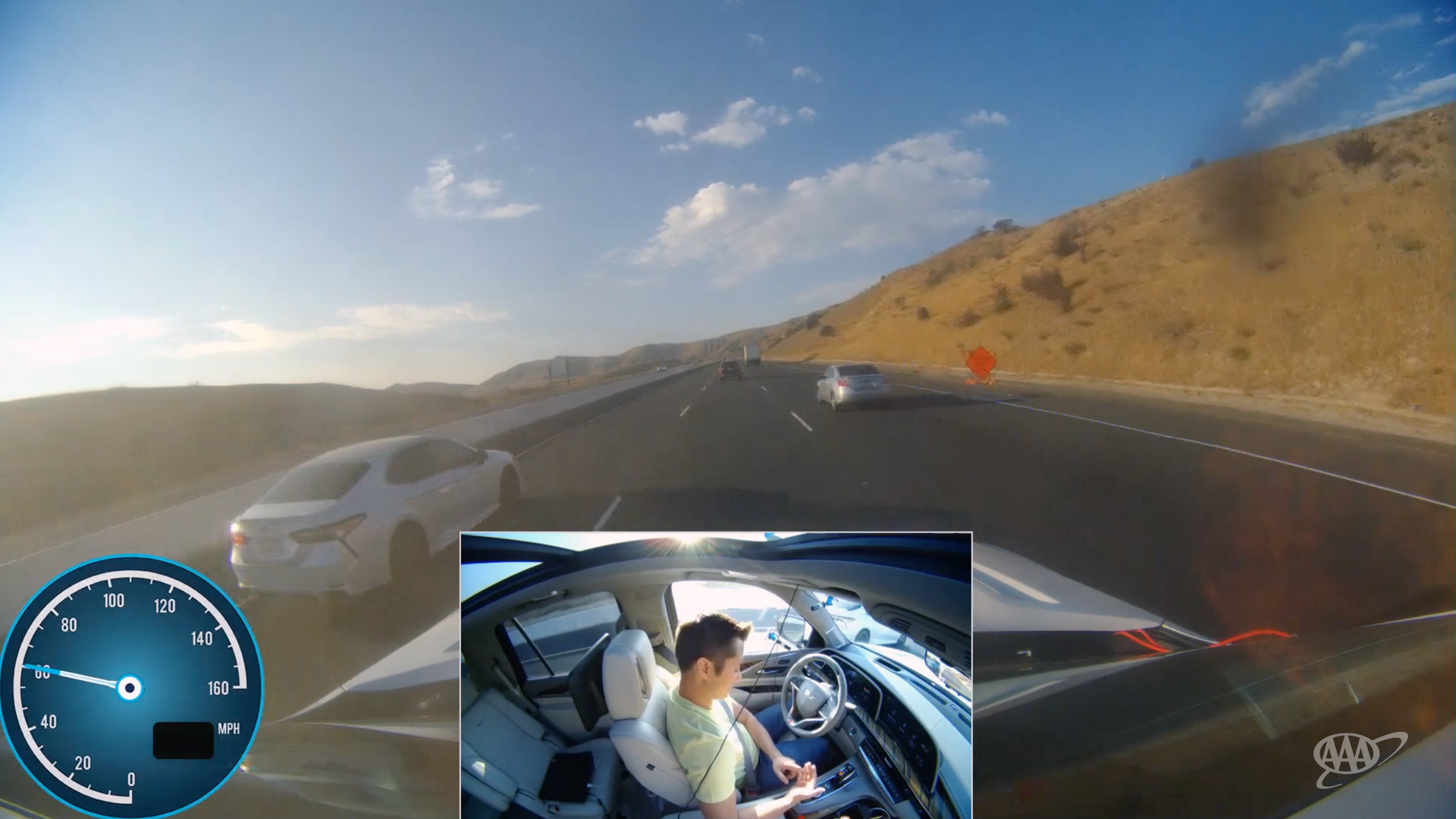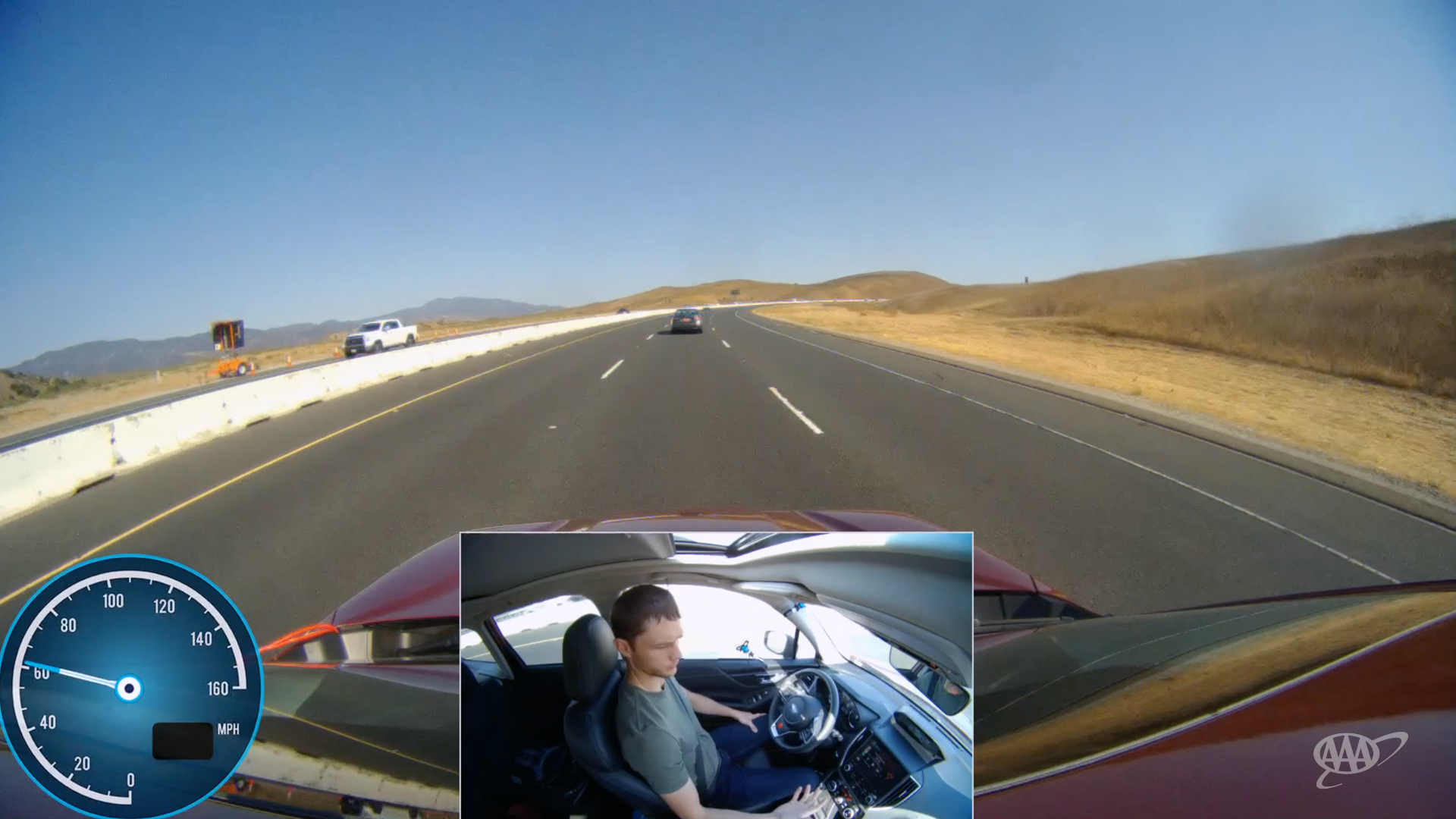PORTLAND, Ore., – As vehicles become more automated, many auto manufacturers realize some technologies may give drivers the false sense that the vehicle can drive itself. To counter this, driver monitoring systems with either a camera or steering wheel detection are used to prevent the deadly consequences of a distracted driver. However, new real-world testing by AAA finds these systems need significant improvements and drivers who want to cheat the systems can easily do so.
Here are B-roll video, fact sheet, and full report.
Active driving assistance systems are widely available and often called semi-autonomous because they combine vehicle acceleration with braking and steering. These technologies include automatic cruise control, automatic emergency braking, and lane keeping assistance. Since these systems have been introduced, there have been numerous newsworthy instances of drivers misusing the systems by watching videos, working, sleeping, or even climbing into the backseat. This behavior can go undetected by the vehicle and, in some cases, result in deadly crashes.
To prevent such activities, vehicles with these driver assistance technologies monitor drivers using either a camera-based system, which watches the driver’s face, or a system that monitors steering wheel movements to detect whether the driver has hands on the steering wheel. The goal of these systems is to make sure that drivers pay attention when behind the wheel.
“Driver assistance technologies are meant to assist drivers, not take over the function of driving. Drivers still have to be engaged and control the vehicle. The key to a safe active driving assistance system is effective driver monitoring that can’t be easily tricked,” says Marie Dodds, public affairs director of AAA Oregon/Idaho. “Driver assistance technologies in vehicles have the potential to improve traffic safety, but not when being used by uninformed or overconfident drivers.”
Distracted driving is a serious problem across the U.S. From 2015 through 2019 There were 23,783 crashes resulting in 158 fatalities, and 23,403 injuries caused by crashes involving a distracted driver in Oregon. https://www.oregon.gov/odot/safety/pages/distracted.aspx
AAA tested driver monitoring systems
AAA test drove four popular makes and models in real-world conditions on a 24-mile loop limited access toll road in southern California to evaluate these systems’ effectiveness.
Key research findings include:
- Camera-based systems alerted disengaged drivers 50 seconds sooner and were more persistent than those detecting steering wheel movement when the driver was looking down with head facing forward, hands off the wheel.
- Camera-based systems alerted disengaged drivers 51 seconds sooner compared to steering wheel movement when the driver was facing away from the road, looking at the center console, with hands off the wheel.
- On average, the percent of time test drivers were engaged was approximately five times greater for camera-based systems than for steering wheel systems.
- Steering wheel monitoring required only minimal input to prevent system alerts, allowing up to 5.65 continuous minutes of distraction (at 65 mph, equivalent to over 6 miles of disengaged driving). In comparison, camera-based systems allowed 2.25 minutes of distraction during the ten-minute long test drive.
- Even after issuing multiple warnings of inattentive driving, both systems failed to disable the semi-autonomous features and force the driver to take the wheel and pay attention.
“The bottom line is vehicles available for purchase today are not capable of driving themselves, regardless of brand names or marketing claims. Driver monitoring systems can be a good first step in preventing deadly crashes but they’re not foolproof,” says Dodds.
AAA’s recommendations:
AAA recommends that automakers opt for camera-based driver monitoring systems over steering wheel monitoring; however, more refinement is required to prevent driver distraction and misuse.
AAA also recommends that disablement of the driver assistance systems should occur after some driver monitoring alerts are issued within a certain period of time.
Before releasing this report, AAA met with automakers to provide insight from the testing experience and specific recommendations for improvement.
Camera-based systems work better than steering wheel-based systems
Vehicles equipped with camera-based driver monitoring systems were significantly better at preventing each type of tested distraction scenario by issuing alerts faster and more persistently than a steering wheel system, no matter the external lighting conditions. On average, the percent of time test drivers were forced to focus on driving was five times greater when facing a camera than with steering wheel input.
Both driver monitoring types were prone to being intentionally fooled, although those using a camera were harder to trick. AAA test drivers attempted to stymie monitoring system alerts with periodic head or eye movement and manipulating the steering wheel. Each driver was given the discretion to develop their cheat strategy, and it should be noted that no external devices, tools, or aids were used.
AAA continues to urge automakers to adopt an industry standard naming convention , for vehicle technology to prevent drivers from misunderstanding the capabilities of catchy, marketing-driven branded names for popular systems.
Methodology
AAA conducted naturalistic driving evaluations on a 24-mile loop on a limited-access toll road in Southern California. The testing used four popular makes and models paired with a leading safety spotter vehicle. All test drivers and spotters were AAA researchers. Each simulated driver distraction test ran ten minutes and used three methods:
- Hands off the steering wheel, head up facing the road but gazing down.
- Hands off the wheel, head and gaze aimed down to the right toward the center console.
- Active circumvention or attempting to “beat the system” through a variation of gaze/head placement and periodic steering wheel input.
AAA selected four vehicles for testing, choosing two of each driver monitoring design type, camera-equipped and input from the steering wheel. The vehicles were as follows:
- 2021 Cadillac Escalade with “Super Cruise™” using a driver-facing infrared camera
- 2021 Subaru Forester with “EyeSight®” and Driver Focus using a driver-facing infrared camera
- 2021 Hyundai Santa Fe with “Highway Driving Assist” (steering wheel)
- 2020 Tesla Model 3 with “Autopilot” (steering wheel)

The driver of the Cadillac Escalade removes hands from the steering wheel and looks down.

The driver of the Subaru Forester removes hands from the steering wheel and faces away from the roadway.
The vehicles were procured directly from the manufacturer or specialty rental fleets. AAA chose the test route due to its consistent traffic volume moving at or near the posted speed limit of 65 mph to make the testing as safe as possible. Please refer to the full report for methodology details, including specific testing equipment and the driving route.
Active driving assistance, which is classified as Level 2 driving automation on SAE International’s scale of Level 0 to Level 5 and includes lane-keeping assistance and adaptive cruise control, provides the highest level of automated vehicle technology available to the public today. It also means that constant driver supervision is required. Most drivers will only interact with vehicle automation through these systems, which according to previous AAA research, are far from 100% reliable.
About AAA
AAA provides more than 62 million members with automotive, travel, insurance, and financial services through its federation of 32 motor clubs and nearly 1,000 branch offices across North America. Since 1902, the not-for-profit, fully tax-paying AAA has been a leader and advocate for safe mobility. Drivers can request roadside assistance, identify nearby gas prices, locate discounts, book a hotel or map a route via the AAA Mobile app. To join, visit AAA.com.
AAA news releases, high resolution images, broadcast-quality video, fact sheets and podcasts are available on the AAA NewsRoom at NewsRoom.AAA.com.
Find local news releases at https://oregon.aaa.com/community/media/media-contacts.html

